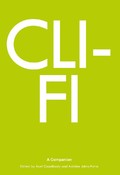The last few days of 2018 saw the appearance of a timely Cli-Fi – A Reader, edited by Adeline Johns-Putra and Axel Goodbody, and including my introductory article on Antti Tuomainen’s The Healer (Parantaja). Contributors to the Reader were encouraged to include reflections on how the novels in question can be used in teaching; the past few years I have taught several courses that included The Healer and from my experiences, this is a novel that opens up a range of perspectives for teaching climate fiction, but also beyond, and including questions in literary urban studies (how is the future city linked to Helsinki’s urban planning visions?) and literary genre studies (is the novel cli-fi, Scandinavian noir, a crime novel?). The Healer is widely translated; hopefully this article will be beneficial also for classrooms and researchers outside of Northern Europe in examining contemporary climate fiction outside of the narrow current Anglo-Saxon canon.

From the article:
Introduction:
“Antti Tuomainen’s Parantaja [The Healer], published in 2010, is set in a near-future Helsinki where climate change is wreaking havoc both in the Finnish capital and abroad. Incessant rains and floods are the most visible climate change-related curses in Tuomainen’s Helsinki, but there is also news of global pandemics, destructive forest fires and water wars. Society is breaking down, and amidst the radical upheaval, a serial killer, the eponymous ‘Healer’ – the ‘healer for a sick planet’ – is murdering people he holds responsible for accelerating climate change. The plot revolves around the endeavours of the protagonist, the Finnish poet Tapani Lehtinen, to find his lost wife Johanna, who is a journalist investigating the murders. As Tapani learns more about the mysterious Healer, he also discovers about the past of his wife, who turns out to have known the Healer intimately. In his journey through flooded Helsinki, Tapani guides the reader on a tour of how different areas in the city, as well as different affected citizens, are coping with the dramatic changes.”
perspectives for teaching:
“One possibility would be to approach the novel in terms of its reception and genre, with a specific focus on how the novel’s implications for climate change depend on the generic prism with which it is approached – Nordic noir or crime fiction; dystopia or climate fiction? A discussion of The Healer in tandem with other Finnish dystopian novels, or as a part of a selection of Nordic speculative fiction, would attune students also to the importance of the cultural and historical specificity of literary responses to climate change outside of the English-speaking world. As a novel set in a recognizable real-world setting, the novel could also be integrated in courses that examine the interaction between fictional texts and urban planning narratives. A last approach would be to examine the novel as part of a course on representations of agency and responsibility in climate fiction. Who is held responsible in this novel for catastrophic climate change, and what room is there for mitigating strategies? Given the role played by climate terrorism in the novel, The Healer could also provide insights in changing (and often genre- and culture-specific) depictions of ecological terrorists.”
From the conclusion:
“The Healer plays on the fear of the future in dystopian and apocalyptic scenarios. Rather than offering concrete insights into the dynamics and the possible effects of climate change, it presents a chilling rendering of what it feels like to live in a society disrupted by radical climate change. The presence of recognizable and everyday environments being turned into war zones, such as the iconic Stockmann department store in central Helsinki during Christmas shopping period, is particularly gripping.”
Source:
“Antti Tuomainen: The Healer.” In Johns-Putra, Adeline & Goodbody, Axel (eds.): Reader in Climate Fiction. Oxford: Peter Lang, 2018, 165-170.

Yes, “cli-fi noir.”